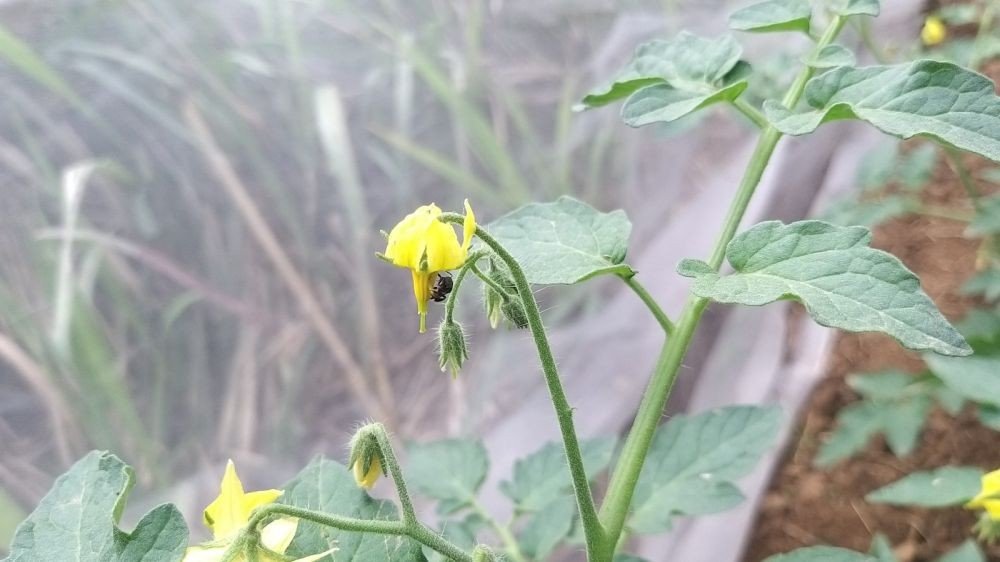LUMAMI, NAGALAND – Researchers at Nagaland University have identified two species of stingless bees, Tetragonula iridipennis Smith and Lepidotrigona arcifera Cockerell, that are proving to be game-changers for agricultural productivity. By introducing these efficient pollinators to various crops, scientists have observed a significant increase in both the yield and quality of produce, offering a sustainable path to enhanced farmer livelihoods.
The Power of Painless Pollinators
Unlike their stinging counterparts, these newly identified stingless bee species offer a safe and effective solution for crop pollination. Beyond their remarkable pollination potential, these bees also produce medicinal honey, providing an additional source of income for farmers. The research highlights the possibility of developing crop pollination calendars, which could greatly benefit agricultural stakeholders by optimizing pollination efforts.
Remarkable Results in Chilli Cultivation
The impact of these stingless bees is particularly evident in chilli cultivation. Nagaland University researchers found that chilli crops pollinated by Tetragonula iridipennis and Lepidotrigona arcifera showed a notable increase in production and quality compared to non-pollinated crops. Specifically:
* King Chilli: Fruit set increased by an impressive 29.46% (from 21.00% in non-pollinated crops).
* Chilli (Capsicum annuum): Fruit set and healthy fruit production saw increases of 7.42% and 7.92%, respectively.
* Seed Weight: A crucial indicator of viability and germination, seed weight increased by 60.74% when pollinated by stingless bees.
To further support chilli pollination, the conservation of other vital pollinators like A. dorsata, A. florea (honeybees), halictid bees, syrphid bees, and Amegiella bees is also being emphasized.
This pioneering research marks the first attempt to fully explore the pollination potential of stingless bees and their contribution to quality honey production, leading to increased income and sustainable livelihoods for farmers. Historically, relying solely on honeybees for pollination presented challenges due to their natural behaviors, leading to inadequate pollination.
The research, spearheaded by Dr. Avinash Chauhan, Scientist and Principal Investigator (AICRP Honeybees & Pollinators) at the Department of Entomology, School of Agricultural Sciences, Nagaland University, has been published in several esteemed peer-reviewed journals, including the International Journal of Farm Sciences.
Dr. Chauhan shared insights into the future direction of this impactful research: “The research outcomes of the last seven to ten years have provided various stakeholders with numerous opportunities to rear stingless bees for quality honey production without fear of impurities and with minimized bee losses, leading to greater profitability in this profession.” He added, “We are continuously working to improve beekeeping rearing techniques and promote scientific beekeeping with both honey bees and stingless bees for enhanced honey production and crop pollination. Our focus also extends to raising awareness about the conservation of other wild honey bees and pollinators.”
The next phase of the research will delve into the pollination of less-known but geographically significant crops such as passion fruit, Solanum spp., and Chow chow. Emphasis will also be placed on developing efficient extraction techniques for stingless bee honey and analysing its medicinal properties through proper analysis and mellisopalynological studies.
Scientific Domestication and Widespread Impact
The current research has focused on utilizing stingless bee species from the Tetragonula and Lepidotrigona genera for pollinating a wide range of crops including cucumber, chilli, king chilli, ash-gourd, watermelon, citrus, tomato, pumpkin, brinjal, and dragon fruit. Stingless bee colonies, traditionally extracted from forests, are now being scientifically multiplied to provide sufficient numbers for confined crop pollination. Their effectiveness has also been observed on fruits like Mango, Guava, Rhus, Gooseberry, and Ber.
While traditional stingless bee rearing has been prevalent in Northeastern and Southern Indian states, the last 7-10 years have seen significant advancements in Nagaland. Scientific domestication, involving the development of specialized hives and mass multiplication through queen cells, has been successfully achieved in Nagaland and is now being extended to states like Meghalaya and Arunachal Pradesh. This breakthrough enables easy multiplication of these bees for pollination and other valuable bee products, empowering farmers to utilize stingless bee colonies in both open field and greenhouse conditions for superior crop yields and quality.
The Vital Role of Pollinators
Pollinators, including honeybees, stingless bees, bumble bees, halictids, and syrphids, are indispensable for maintaining the food and forage cycles within our ecosystems. Their conservation and scientific utilization, particularly the domestication of feral stingless bee colonies, are crucial for sustainable farming practices in Northeast India. The diverse physiographic and ecoclimatic conditions of the Northeastern states (Arunachal Pradesh, Assam, Meghalaya, Mizoram, Manipur, Nagaland, Sikkim, and Tripura) make them ideal for propagating stingless bee colonies, contributing significantly to biodiversity preservation.
In open field conditions, a holistic approach to chilli pollination involves the conservation of stingless bees, honeybees, and Diptera fauna, alongside non-Apis bees. Without adequate pollination, chilli yield and quality suffer substantially. This research underscores the vital role of stingless bees, honeybees, and halictid bees as primary pollinators for chilli crops.

